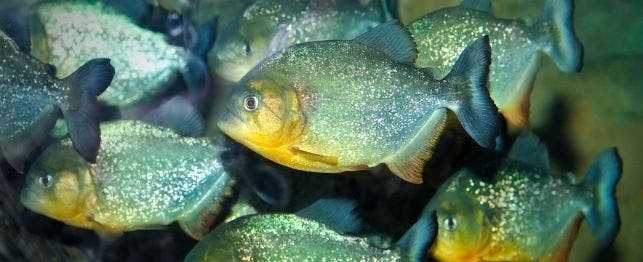
Choosing a Piranha
If aquariums are your hobby and you are interested in a challenge, a tank of piranhas may be just right for you. Not for the faint of heart, piranhas require careful monitoring, feeding and tank maintenance. These fish are best suited to experienced aquarists.
Appearance and Behavior
In the home aquarium, piranhas (Serrasalmus nattereri) will reach about 8 to 10 inches in length if given enough room. They have a silvery-gold color, a red throat, and a mouth full of razor sharp teeth designed for tearing flesh. They are found naturally in the waters of South America and Guyana and it is illegal to import or export them in many countries. They are dangerous aggressive fish. Piranhas live in schools, which further enhances their aggression. Frenzied feeding behavior excites the fish in the school and prey can be devoured in seconds. Individual fish are less aggressive then those that live in schools but will still attack if they are distressed or frightened. Because of a lack of socialization, piranhas raised as single fish cannot be added to a group at a later time.
Nutrition
These fish eat only meat and their preference is live prey. Feeder goldfish, minnows and earthworms are usual food sources. Beef heart, or fish fillets may be accepted. Resist the temptation to hand feed these fish; they can easily bite a finger and leave a serious wound.
Special Concerns
Because of their high protein diet, piranhas produce a lot of waste products, which can easily foul the tank water. Ammonia is a breakdown product of protein metabolism so this too is a concern. Extra filtration will be necessary and the addition of ammonia filtration cartridges will help keep the water clean. If you want to keep tank mates with your piranhas, it is best to have the other species established in the tank first, then add the piranhas and limit the number you add to one or two. Piranhas kept with other fish need to be fed frequently to keep them from devouring their tank mates. Keep only larger, more aggressive fish with piranhas. Some species to try include Oscars, Jack Dempsey and Green Terrors. Expect a lot of fighting and injury when combining these fish in any tank. If your piranhas don’t work out well for you, please find a reputable home for them through a hobby club, aquarium store or local zoo. If released to the wild these fish can breed and become a concern in public waterways.